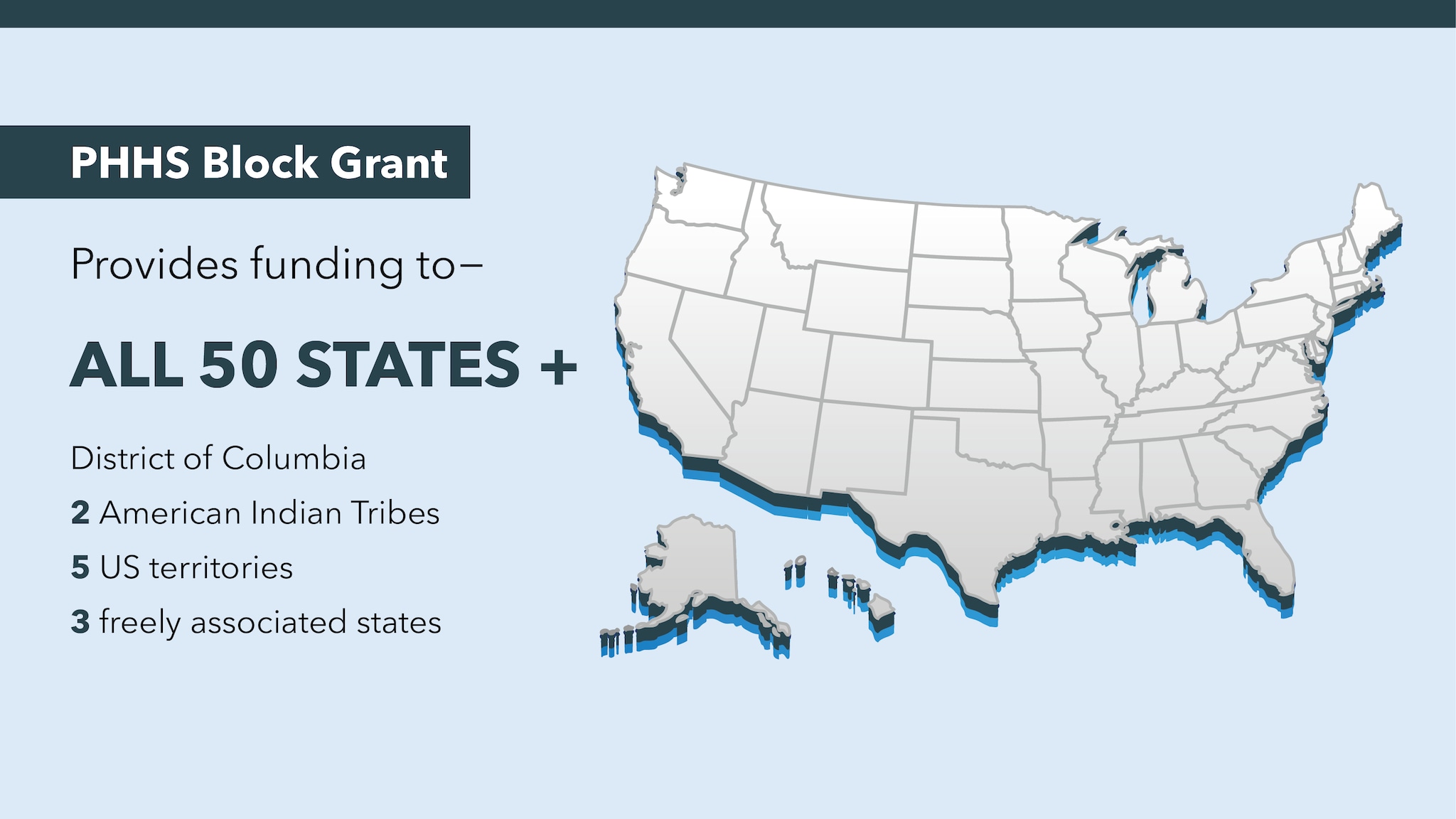Key points
- Preventive Health and Health Services (PHHS) Block Grant funding helps support unfunded or underfunded public health needs, including prevention services and outbreak control.
- Health departments use this flexible funding where communities need it most, supporting a wide range of activities to build, improve, and sustain local public health.
- All 50 states, District of Columbia, 2 American Indian tribes, 5 US territories, and 3 freely associated states are funded.

Overview
For more than 40 years, the Preventive Health and Health Services (PHHS) Block Grant has supported essential public health services in all 50 states, 5 US territories, 3 freely associated states, and 2 tribes. Health departments use this flexible funding where communities need it most, supporting a wide range of activities to build, improve, and sustain local public health.
The PHHS Block Grant Program allows states, territories, and tribes to—
- Address emerging health issues and gaps.
- Decrease premature death and disability.
- Achieve health equity by addressing social determinants of health.
- Support local programs to achieve healthy communities.
- Establish data and surveillance systems to monitor health status.
New resource available from ASTHO!
Program priorities
Recipients use Block Grant funding to advance national health objectives set by Healthy People 2030. To achieve these objectives, the PHHS Block Grant Program supports and targets—
- Emerging needs – allowing recipients to address unique problems in their jurisdictions.
- Implementation – supporting both building and using evidence-based practices for effective public health work.
- Quality improvement – implementing efforts to achieve operational, program, or service efficiencies and effectiveness.
- Preventive health services – implementing screenings, injury prevention, and health education.
Success is achieved by—
- Using evidence-based methods and interventions
- Reducing risks like poor nutrition, smoking, and physical inactivity
- Establishing policy, social, and environmental changes
- Monitoring and evaluating funded programs
- Leveraging resources to build, improve, and sustain public health programs
How is the PHHS Block Grant Used?
Health departments rely on Block Grant funding to support critical programs and services when other resources are unavailable or inadequate. Funds help to start, maintain, expand, restore, and sustain public health efforts.
The PHHS Block Grant is used to support outpatient clinical services, preventive screening, laboratory support, outbreak control, workforce training, and public education. Additionally, it supports data surveillance, and program evaluation. The PHHS Block Grant is used to address a wide range of health problems including injury and violence prevention, nutrition, infectious diseases, heart disease and stroke, maternal and child health, and oral health.
Because of the difference in funding allowances, no two states use their Block Grant resources in the same way. Additionally, no two states provide similar amounts of funding to the same program or activities.
Did you know?
States invest their PHHS Block Grant dollars in a variety of public health areas. PHHS Block Grant dollars are used to support existing programs, implement new programs, and respond to unexpected emergencies.
State and Community Efforts
Data collected in 2022 on how PHHS Block Grant funds are used showed:
Timeline
History of the PHHS Block Grant Program
- 1981: Omnibus Budget Reconciliation Act of 1981 (Public Law 97-35) - Authorized a series of health and social services block grants. Grants were given to states to carry out programs that were previously authorized separately. The original legislation combined several categorical grants covering emergency medical services, hypertension, home health services, health education and risk reduction, urban rodent control, and community water fluoridation.
- 1992: Public Law 102-531 - Section 1905 of the PHHS Block Grant was amended. New legislation mandated that Block Grant be solely devoted to the nation's health objectives outlined by the Healthy People initiative.
- 1996: Public Law 102-531 - Section 1910A was added to include allotments for rape prevention and education. This amendment authorized additional monies for rape prevention and education programs. Twenty-five percent was given to middle, junior, and high school students for education programs.
- 2000: Public Law 102-531 - Section 1910A was repealed from the PHHS Block Grant. A new Public Law 106-386 was passed and continued to authorize monies for rape prevention and education programs.

